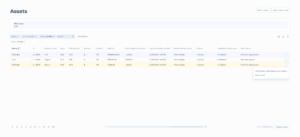Assets
14. 01. 2025

Assets are the currencies or other assets used and accounted for by the system. The system can operate with assets connected to real currencies such as EUR or USD or it can operate with crypto currency, or with internal assets such as internal digital currency or bonuses etc.
The main Assets screen provides an overview and management interface for all assets within the system. Below are the details of each component and related actions:
Components:
- Assets List:
-
-
- Name: The name of the asset (e.g., US Dollar, Euro).
- ID: A unique identifier for the asset.
- Currency type: a type of currency such as Fiat, Crypto or Bonus.
- Code: The currency code (e.g., USD, EUR).
- Digital Code: The ISO 4217 numeric code for the currency (e.g., 840 for USD).
- Symbol: The symbol used for the currency (e.g., $, €).
- Fraction: The smallest unit of the currency, typically 100.
- Liability: The amount of liability associated with the asset.
- Commissions Collected: The total amount of commissions collected for the asset.
- Last Reconciliation Date: The date when the asset was last reconciled.
- Reconciliation Status: The status of the reconciliation (e.g., Reconciled).
- Status: The current status of the asset (e.g., Active).
- Available for exchange: indicates if the operation of currency exchange for this currency is allowed or not (Enabled, Disabled).
- Description: A description of the asset.
-
- Filters:
-
- Filter assets by their status, type or name.
- Search: A search bar to find specific assets by name or other attributes.
- Actions:
- Main Asset: A button to view and set the main asset.
- Add New Asset: A button to open the form for creating a new asset.
- Context Menu: Each asset has a context menu (three dots) with additional actions:
- Withdraw Collected Commission: Opens a form to withdraw the collected commission.
- Edit Asset: Opens a form to edit the asset details.